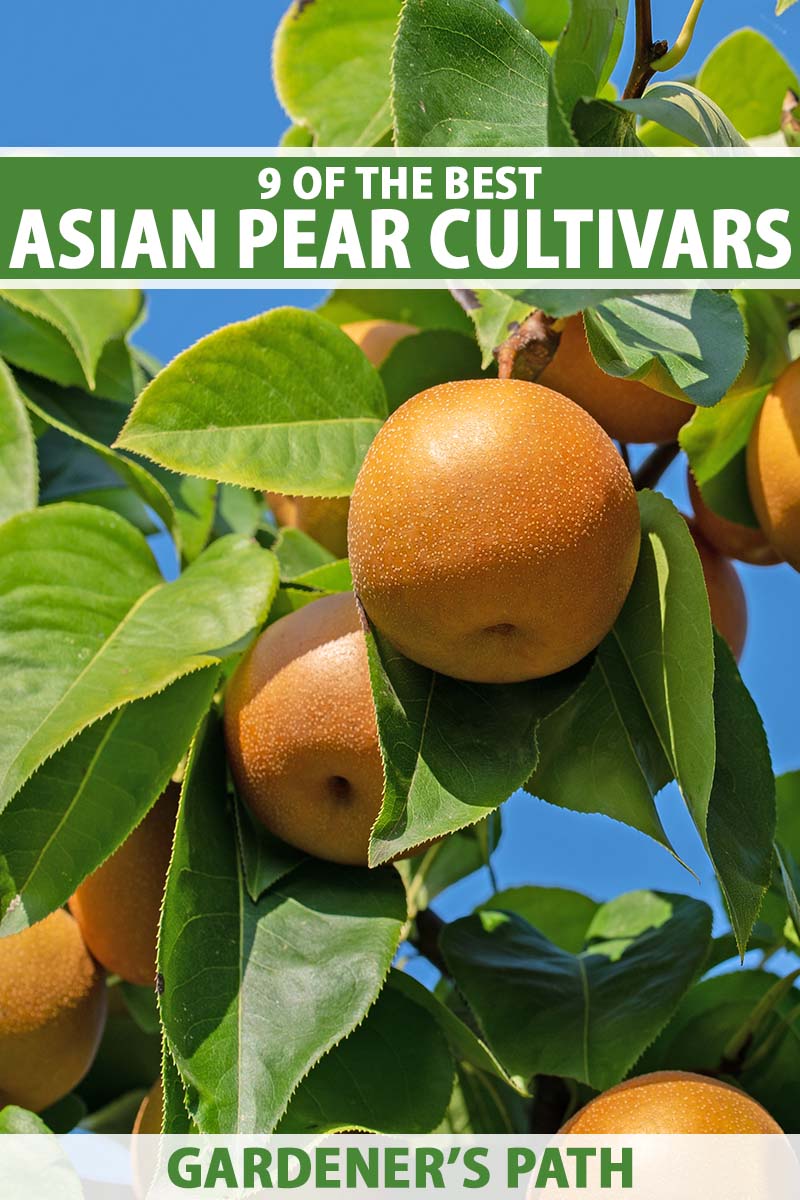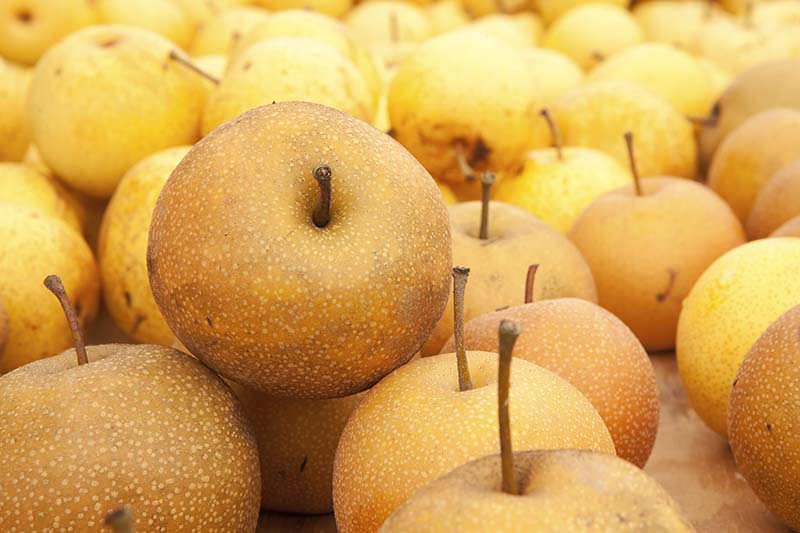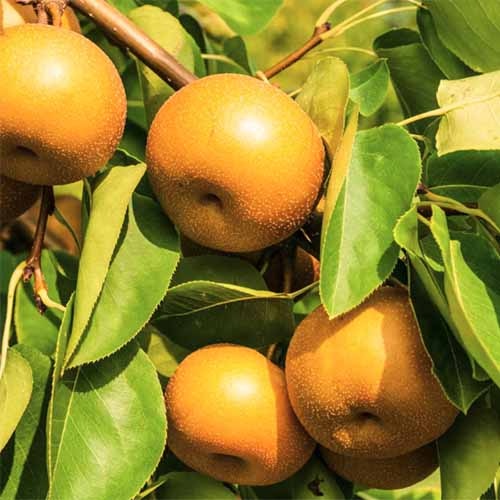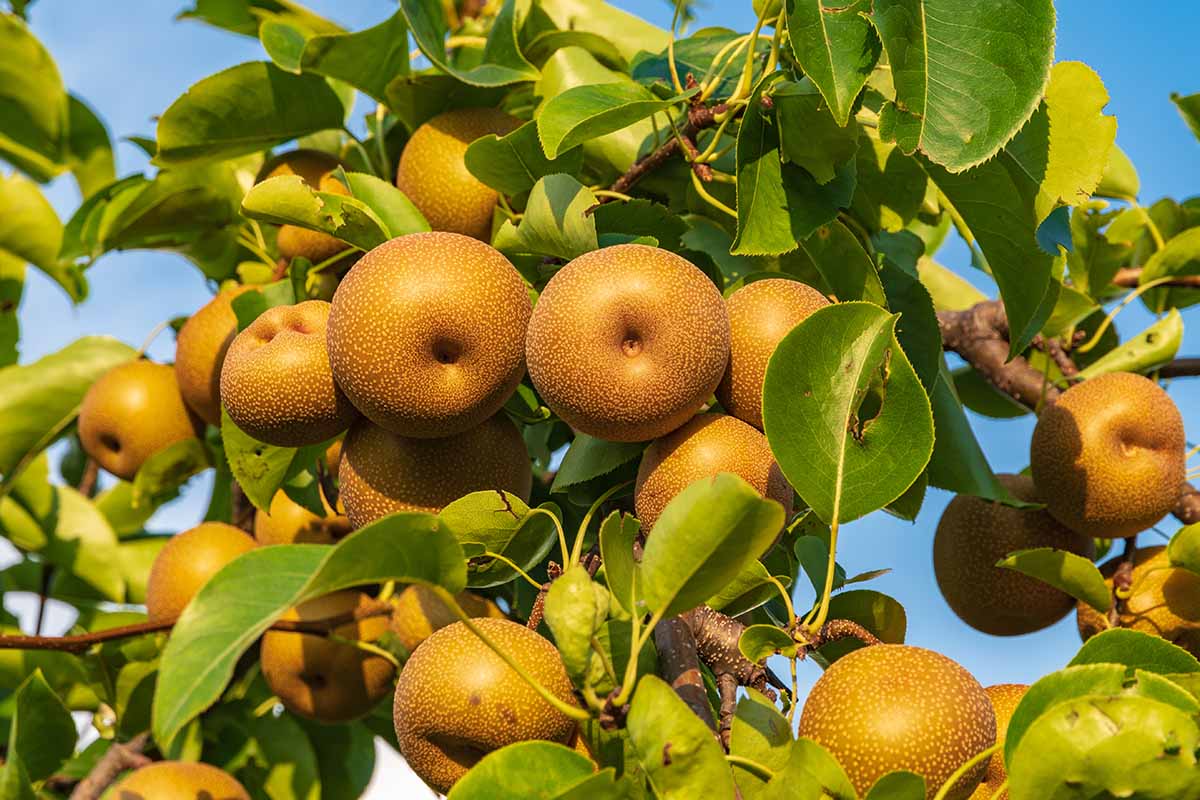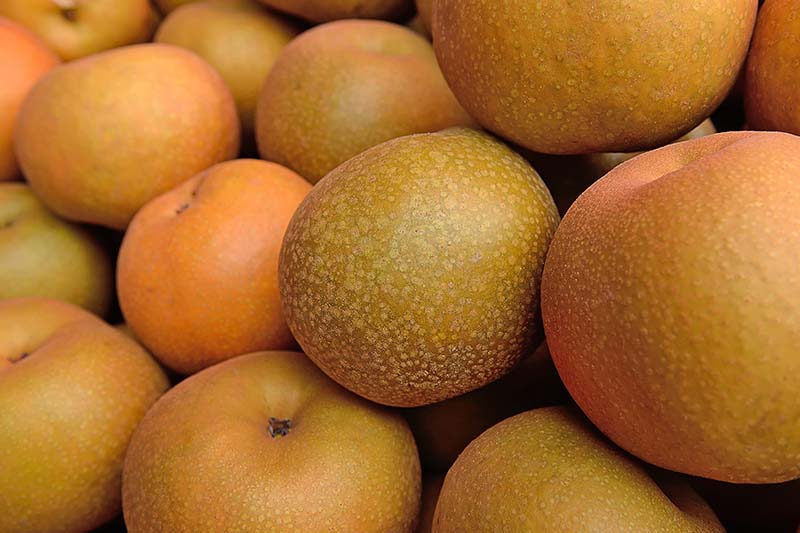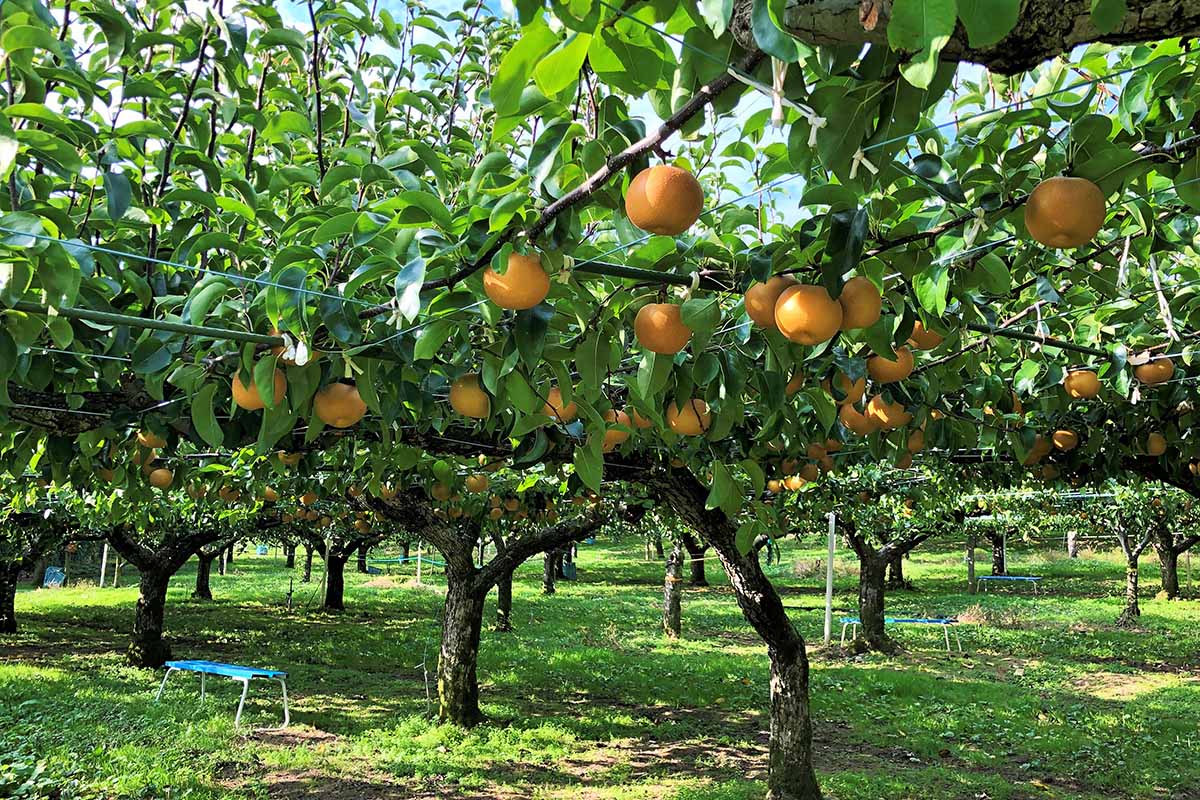Distinct in flavor and shape from their European cousins, the fruit has a rounded appearance like an apple and skins can be rough or smooth, with colors ranging from creamy pink, pale green, and yellow to bronze and russet, depending on the type. Also different from European varieties, Asian pears are allowed to ripen on the branch from late summer to mid-autumn, and don’t require conditioning in cold storage before eating. Many commercially available cultivars are dwarf or semi-dwarf in size, and work nicely in small gardens. They also have low chill hour requirements, making them suitable for growing in areas with mild winters. We link to vendors to help you find relevant products. If you buy from one of our links, we may earn a commission. Beautiful and productive, with three full seasons of interest and a handsome winter silhouette, many also have good disease resistance for easy care and maintenance – a winning combination of traits by any standard! Now, let’s have a look at nine of the best Asian pear varieties for the home garden. Here’s what’s ahead: Asian pears, Pyrus pyrifolia, also known as apple, Chinese, or sand pears, are highly aromatic and tasty, and available in two different forms. The smooth-skinned varieties typically have green or yellow skin, and a mild, sometimes melon-like or floral, sweet flavor. The rough-skinned varieties have bronze, brown, or russet skin with a full pear flavor, often marked by sweet tones of brown sugar, butterscotch, or caramel. Delicious when eaten raw for dessert or a snack, in salads, and with cheese or nut trays, they’re also used in jams and sauces, or steamed. A popular ingredient in marinades, the enzyme calpain that they contain tenderizes proteins. Asian pears are ripened on the tree, and are ready for harvest when the flesh is still firm and skins take on mature colors. The average storage life for the harvested fruit is two to three months, although a few cultivars like ‘Olympic Giant’ and ‘Shinseki’ can last for several months in the right environment. For storage, the ideal conditions are 32°F with a relative humidity of 90 to 95 percent. Most varieties of Asian pear are self-pollinating and produce adequate crops when planted on their own. But all benefit from cross-pollination and produce greater yields when planted with other pear trees with the same bloom time. And they have low chill hour requirements of only 350 to 500 hours at 45°F or lower, which makes them a good choice in areas with mild winters. You can find all the cultivation and pollination details you’ll need in our guide to planting and growing Asian pear trees. Join us as we take a look at nine of the best Asian pear cultivars for the home garden.
1. 20th Century
Also known as ‘Nijisseiki,’ ‘20th Century’ is highly popular for its abundance of juicy fruit and ornamental, multi-season interest. The attractive, midsized fruit is golden yellow with a hint of rosy blush, and has a crisp texture and mild flavor. Before the leaves show, branches are covered in clusters of showy white blossoms. Fruit is harvested beginning in early August, and in autumn, the glossy green leaves turn a vibrant orangey-red. ‘20th Century’ The pyramid shaped trees reach a height of 12 to 18 feet, and spread 12 to 15 feet. They are hardy in USDA Hardiness Zones 5 to 9. These are self-fertile but deliver a greater crop when cross-pollinated with other varieties with the same midseason bloom time. A good keeper, fruits store well for four to five months in cold storage at 32°F. Container trees are available at Nature Hills Nursery.
2. Chojuro
A favorite of the home gardener, ‘Chojuro’ has firm, gold-to-russet fruit with a luscious crunch and the distinctive, sweet flavor of butterscotch. This type of Asian pear has a midseason bloom time, producing beautiful clusters of creamy white blossoms. In fall, the leaves are brilliant in shades of crimson and deep orange. The fruit ripens on the branch in late August to mid-September, and these pomes have a long storage life of up to six months in refrigeration. ‘Chojuro’ ‘Chojuro’ grows in a rounded, upright form and reaches a mature height of 12 feet with a spread of up to eight feet. It’s hardy in Zones 5 to 8. Self-pollinating, this variety will produce a greater crop of pears when cross-pollinated with others that share the same bloom time, such as ‘20th Century.’ Bare root trees are available at Nature Hills Nursery.
3. Drippin’ Honey
‘Drippin’ Honey’ is a beautiful cultivar with large, lightly russeted amber-gold fruits with creamy white flesh that has a crisp texture and a delightful honey-sweet flavor. A heavy producer, clouds of white blossoms flower in early to mid-season, and the pears are harvested in October. The waxy green leaves put on a pretty autumn display in shades of orange and red. ‘Drippin’ Honey’ Easy to care for, with good resistance to fire blight, the rounded trees reach a mature height of 16 to 20 feet with a 16-foot spread. ‘Drippin’ Honey’ is hardy in Zones 5 to 8. For pollination, plant with at least one other pear tree with the same bloom time. Excellent for use as a storage fruit, the harvest will keep for up to six months in refrigeration. Bare root trees can be found at Home Depot.
4. Hosui
‘Hosui’ is favored for its tasty, honey-russet fruit with firm white flesh, a sweetly tart flavor, and fantastic crunch. It produces an abundance of blossoms in early spring, and the round, medium-sized fruits are ripe and ready for harvest starting in mid-August. These put on a brilliant fall show as the leaves turn shades of yellow, flame orange, and scarlet. ‘Hosui’ The shape at maturity is loosely columnar, and reaches a height of 10 to 15 feet with a spread of eight to 12 feet. ‘Hosui’ is hardy in Zones 4 to 9. Self-pollinating, this cultivar does best when planted with other early bloomers. The fruit has a good shelf life of four to five months in refrigeration. Bare root trees can be purchased at Burpee.
5. Kosui
‘Kosui’ produces medium-sized amber fruit with bronze russeting and full-flavored, sweet flesh with a juicy crunch that stores for up to two months in refrigeration. The trees are covered in pretty white blossoms with an early to midseason bloom time, and the pears ripen in mid-July to August, followed by autumn colors of yellow to red. A vigorous variety with an upright, columnar shape, these trees reach a height of 15 to 20 feet and spread about 12 feet. ‘Kosui’ trees require cross-pollination with other early bloomers, and are hardy in Zones 4 to 9.
6. Niitaka
Highly productive, ‘Niitaka,’ aka ‘Singo,’ is noted for its abundance of large caramel-russet fruit with an occasional pink blush. The flesh is off-white with a crisp, juicy texture and mild, melon-like flavor. The rounded trees have a mature height of 10 to 15 feet with a spread of 10 to 12 feet. They have an early season flowering time and fruits ripen in September and October, with a storage life of two to four months in refrigeration. These trees are self-pollinating, but yield greater crops when planted with other early season bloomers. ‘Niitaka’ is hardy in Zones 4 to 9.
7. Olympic Giant
Also known as ‘Korean Giant,’ ‘Olympic Giant’ produces extra-large pears of russeted green-gold with cream-colored flesh that has a crisp, juicy bite and a sweet taste of butterscotch. The rounded trees flower in midseason and put on a fiery fall display of reddish-orange foliage. They grow 16 to 18 feet tall with a spread of 12 to 16 feet, and the fruit ripens in mid- to late October. ‘Olympic Giant’ One of the best-keeping Asian pears, ‘Olympic Giant’ has an excellent shelf life of up to six months in refrigeration. This cultivar is not self-pollinating, and requires others with a similar midseason flowering time for cross-pollination. Bare root trees are available at Home Depot.
8. Shinseiki
The ‘Shinseiki’ variety, also known as ‘New Century,’ is very productive and features medium fruit with crisp, white flesh, a mildly sweet flavor, and a juicy bite. The almost-translucent skin comes in shades of pale yellow to celery green, and is freckled with small, green to brown lenticels (or raised pores). An early bloomer with a dense display of blossoms, the fruit ripens in late August to mid-September. Mature trees reach a height of 12 to 18 feet with a spread of 10 to 12 feet in a pleasant, rounded shape, and give a pretty fall display in vivid shades of orange and red. ‘Shinseiki’ ‘Shinseiki’ trees are self-pollinating but provide larger yields when cross-pollinated with others in the early flowering group. Hardy in Zones 5 to 9, the pears have a good storage life of four to six months in refrigeration. ‘Shinseiki’ container trees are available at Nature Hills Nursery.
9. Yoinashi
Aromatic and sweetly flavored of butterscotch with light floral notes, ‘Yoinashi’ develops medium-sized fruit with lightly russeted gold-to-bronze skin and crisp, juicy flesh. An early season bloomer, beautiful white blossoms adorn the rounded trees that grow eight to 15 feet in height with a similar spread. The fruit ripens from mid-August to mid-September and has a storage life of two to three months. In fall, the leaves take on hues of bright orange and scarlet. ‘Yoinashi’ has good resistance to fire blight and is hardy in Zones 5 to 10. These trees are self-pollinating but produce larger crops when cross-pollinated with other early season varieties.
Beauty and Flavor
Productive, easy to harvest, and uniquely flavored, Asian pear trees also add beauty to the garden with masses of spring blossoms and fiery autumn colors. They’re available in a variety of sizes from dwarf to standard, making them suitable for even small yards. And remember that even with self-pollinating trees, planting a second one that flowers at the same time ensures an abundant, bountiful crop. Do you folks have a favorite variety? Let us know in the comments section below. And for more information about growing pear trees in your garden, check out these articles next:
How to Prepare Fruit Trees for WinterHow to Propagate Pear Trees from CuttingsHow to Grow Fruiting Pear Trees
